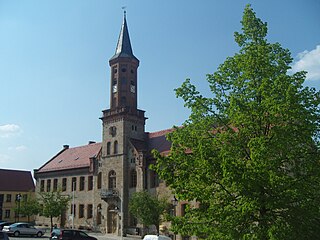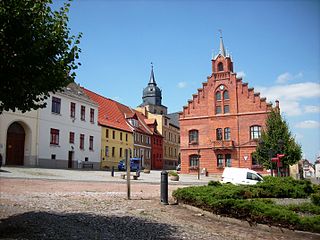
Merseburg is a town in central Germany in southern Saxony-Anhalt, situated on the river Saale, and approximately 14 km south of Halle (Saale) and 30 km west of Leipzig. It is the capital of the Saalekreis district. It had a diocese founded by Archbishop Adalbert of Magdeburg. The University of Merseburg is located within the town. Merseburg has around 35,000 inhabitants.

Saxony-Anhalt is a state of Germany, bordering the states of Brandenburg, Saxony, Thuringia and Lower Saxony. It covers an area of 20,451.7 square kilometres (7,896.4 sq mi) and has a population of 2.17 million inhabitants, making it the 8th-largest state in Germany by area and the 11th-largest by population. Its capital is Magdeburg and its largest city is Halle (Saale).

Lützen (help·info) is a town in the Burgenlandkreis district of Saxony-Anhalt, Germany.

Zeitz is a town in the Burgenlandkreis district, in Saxony-Anhalt, Germany. It is situated on the river White Elster, in the triangle of the federal states Saxony-Anhalt, Thuringia and Saxony.

Leuna is a town in Saxony-Anhalt, eastern Germany, south of Merseburg and Halle, on the river Saale.

Weißenfels is the largest town of the Burgenlandkreis district, in southern Saxony-Anhalt, central Germany. It is situated on the river Saale, approximately 30 km (20 mi) south of Halle.

Bernburg (Saale) is a town in Saxony-Anhalt, Germany, capital of the Salzlandkreis district. The former residence of the Anhalt-Bernburg princes is known for its Renaissance castle.

Bad Lauchstädt (help·info), officially Goethestadt Bad Lauchstädt, is a town in the district Saalekreis, Saxony-Anhalt, Germany, 13 km southwest of Halle. Population 8,781 (2020).

Landsberg is a town in the Saalekreis in the state of Saxony-Anhalt, Germany

Könnern (help·info) is a town in the district of Salzlandkreis, in Saxony-Anhalt, Germany. It is situated on the right bank of the river Saale, approx. 15 km south of Bernburg, and 25 km northwest of Halle (Saale).

Alsleben is a town in the district of Salzlandkreis, in Saxony-Anhalt, Germany. It is situated on the river Saale, south of Bernburg. It is part of the Verbandsgemeinde Saale-Wipper.

Zörbig is a town in the district of Anhalt-Bitterfeld in Saxony-Anhalt, Germany. It is situated approximately 15 km west of Bitterfeld, and 20 km northeast of Halle (Saale). Zörbig is well known for its molasses made from sugar beets.

Bad Dürrenberg is a spa town in the Saalekreis district, in Saxony-Anhalt, Germany. It is situated on the river Saale, approx. 8 km southeast of Merseburg. It is known for its graduation tower, the largest one in Germany.

Schraplau is a town in the Verbandsgemeinde Weida-Land, part of the district of Saalekreis, in the State of Sachsen-Anhalt, Germany. It is situated approximately 8 km (5 mi) northeast of Querfurt. It is also considered part of the Halle-Leipzig metropolitan area.

Kabelsketal is a municipality in the Saalekreis district, in Saxony-Anhalt, Germany. It is situated east of Halle (Saale). It was formed in 2004 out of the villages of Dieskau, Dölbau, Gröbers und Großkugel.
Saalekreis is a district in Saxony-Anhalt, Germany. The district seat is Merseburg. Its area is 1,434.2 km2 (553.7 sq mi). It is bounded by the districts Kyffhäuserkreis (Thuringia), Mansfeld-Südharz, Salzlandkreis, Anhalt-Bitterfeld, Nordsachsen, Leipzig and Burgenlandkreis. The district-free city of Halle is surrounded by the Saalekreis.

Arzberg is a municipality in the district Nordsachsen, in Saxony, Germany.

The Middle German Chemical Triangle is the industrial conurbation around the cities and towns of Halle (Saale), Merseburg and Bitterfeld in the North German state of Saxony-Anhalt and Leipzig and Schkeuditz in the Free State of Saxony. Its name is derived from the dominant industries of the region – the chemical and oil refining industries.
Buna Werke Schkopau were a chemical company specialising in the production of polymer materials such as plastics and artificial rubber. The name BUNA is derived from the technology of polymerising butadiene with sodium as a catalyst.


























